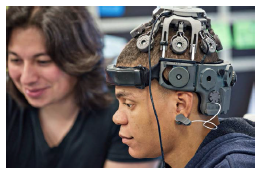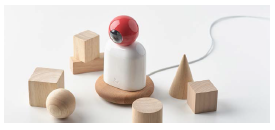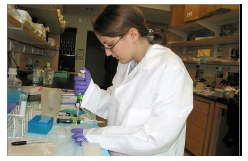Breakthrough Brain Computer Interface for AR/VR
Trend Watch: Patches, baby monitors, BCI, artificial skin, and blockchain move healthcare into the future.
 Neurable, a developer of brain-computer interface (BCI) technology based on breakthrough neuroscience, has raised a $2 million seed round to bring its software platform to market. Neurable’s patent-pending technology interprets intent based on users’ brain activity, enabling real-time control of software and connected devices using only the power of the brain. The company is developing a software development kit for integration of its technology with virtual/augmented reality content and headsets.
Neurable, a developer of brain-computer interface (BCI) technology based on breakthrough neuroscience, has raised a $2 million seed round to bring its software platform to market. Neurable’s patent-pending technology interprets intent based on users’ brain activity, enabling real-time control of software and connected devices using only the power of the brain. The company is developing a software development kit for integration of its technology with virtual/augmented reality content and headsets.
Neurable performs complex data analyses using novel machine learning approaches, which provide significant advantages in speed and accuracy when determining user intent. Neurable offers a powerful new method for interaction in AR/VR applications, solving many of the current problems with user experience. Neurable offers a hands-free method for control while avoiding the limitations of other technologies such as eye-tracking or voice commands. With Neurable, users can control menus and options in AR displays, or create magic and cast spells in VR games, all through the power of their brains. Neurable is non-invasive and uses dry-electrode sensors to record brain activity. It is also wireless, so it does not impair users’ movement.
Neurable will license its software sevelopment kit to manufacturers of AR/VR headsets and to content developers. The kit is platform agnostic and compatible with all leading AR/VR headsets, including Oculus Rift, HTC Vive, and the Microsoft HoloLens.
The Neurable SDK includes plugin support for leading game engines such as Unity and Unreal as well as Qt, a platform for UI, application, and embedded device development.
Neurable’s software kit will be released to select developers in the second half of 2017.
Non-Contact Smart Baby Monitor Gets J&J Backing
 Ray, a baby monitor developed by Indian start-up company Ray IoT Solutions, in partnership with Johnson & Johnson and the HAX hardware accelerator program, is marketed as the world’s first and only non-contact sleep and breathing tracker. The monitor features a sensitive microphone, speaker, low light video camera and an advanced micro-power ultra-wideband radar sensor that measures body movement and respiratory rate from a distance. Besides general presence and sleep tracking, the hospital-grade sensor can also detect irregularities like fever, asthma or bronchitis, as well as acute conditions that may lead to accidental suffocation. It’s capable of picking up even the smallest variations, which it logs in a digital health journal, and can emit emergency alerts.
Ray, a baby monitor developed by Indian start-up company Ray IoT Solutions, in partnership with Johnson & Johnson and the HAX hardware accelerator program, is marketed as the world’s first and only non-contact sleep and breathing tracker. The monitor features a sensitive microphone, speaker, low light video camera and an advanced micro-power ultra-wideband radar sensor that measures body movement and respiratory rate from a distance. Besides general presence and sleep tracking, the hospital-grade sensor can also detect irregularities like fever, asthma or bronchitis, as well as acute conditions that may lead to accidental suffocation. It’s capable of picking up even the smallest variations, which it logs in a digital health journal, and can emit emergency alerts.
Patch Provides Real-Time, Continuous Glucose Monitoring
Sano Intelligence is prototyping a patch that can continuously track blood glucose using small electrical signals. It will launch in beta sometime this summer.
Sano’s minimally invasive wearable patch measures interstitial fluid in the skin’s outer layer to provide real-time, continuous glucose monitoring to a mobile app.
Sano founder and CEO Ashwin Pushpala told Forbes that traditional preventive health is “fundamentally wrong" in its approach. The company has raised $18.75 million to develop the wearable sensor that, instead of counting steps, assesses things like blood sugar so users can see the impact of dietary changes on individual bodies.
“Our technology can generate an individual’s health data points in real time and in a comfortable, accessible way. It helps people make faster, more informed decisions to optimize eating options and behaviors," Pushpala reported.
Artificial Skin Can Detect Temperature Changes
 According to a report in the Science Robotics journal, Caltech and ETH Zurich scientists and engineers have created an artificial skin that is able to detect temperature alterations. The mechanism that helps it detect the change of temperature is akin to the method used by organs that enables a pit viper to perceive their prey.
According to a report in the Science Robotics journal, Caltech and ETH Zurich scientists and engineers have created an artificial skin that is able to detect temperature alterations. The mechanism that helps it detect the change of temperature is akin to the method used by organs that enables a pit viper to perceive their prey.
This artificial skin could be used for grafting while operating on prosthetic limbs allowing restoration of temperature sensation in amputees.
The artificial skin may also be used in bandages to alert physicians of increase in temperature, indicating infection or wound persisting in an affected area. This artificial layer of skin can detect almost 5 to 50 degree Celsius temperatures, which is quite beneficial for biomedical applications and robotics.
Funded by Swiss National Science Foundation, the research paper is entitled Biomimetic temperature-sensing layer for artificial skin.
IBM Collaborates with FDA on Blockchain Health Data
IBM Watson Health is working with the Food and Drug Administration to develop a secure, efficient, and scalable exchange of health data using blockchain technology. IBM and the FDA will explore the exchange of data from several sources, such as electronic medical records, clinical trials, genomic data, and health data from mobile devices, wearables, and the Internet of Things. The initial focus will be on oncology-related data.
By keeping an audit trail of all transactions on an unalterable distributed ledger, blockchain technology establishes accountability and transparency in the data exchange process.
IBM and the FDA will explore how a blockchain framework can provide benefits to public health by supporting important use cases for information exchange across a variety of data types. (PV)



















